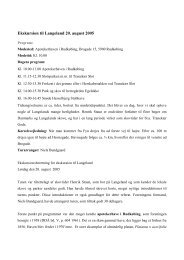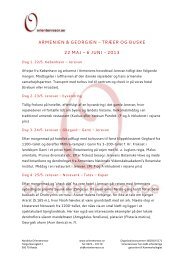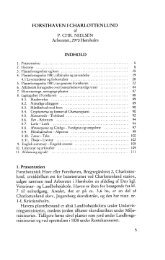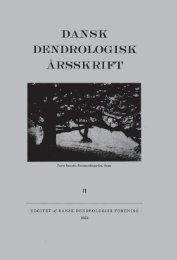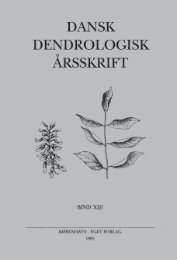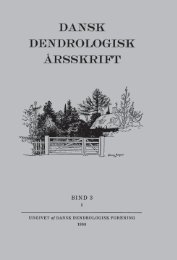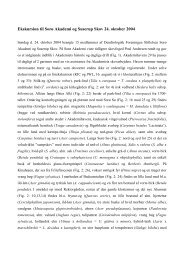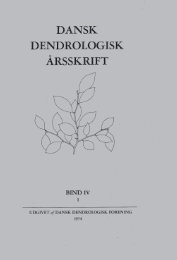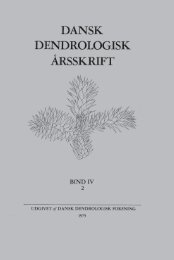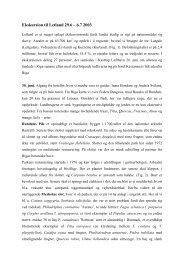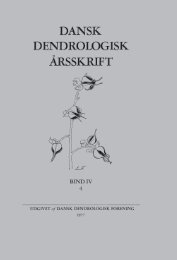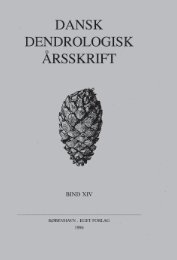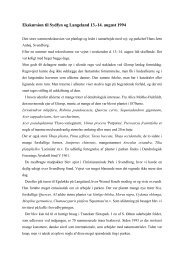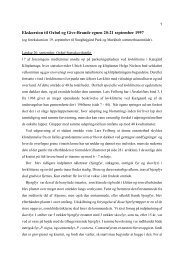Volume 2,1 (1963) - Dansk Dendrologisk Forening
Volume 2,1 (1963) - Dansk Dendrologisk Forening
Volume 2,1 (1963) - Dansk Dendrologisk Forening
Create successful ePaper yourself
Turn your PDF publications into a flip-book with our unique Google optimized e-Paper software.
specimen, the description of which will get a supply of characters<br />
added to the original one from observations on the various growing<br />
places of this single individuum. We must never forget that there is<br />
an enormous abyss between our concept of a new species (a Rock<br />
number f.i.) and of an in our mind good old one as f.i. Picea Abies<br />
(L.) Karst. Let us suppose that travellers from another part of the<br />
world had brought home some seeds of Picea from various parts of<br />
the unknown Europe, and that of each collector-number one single<br />
specimens grew until fructification in the arboretum, we might have<br />
had several well described (but not well defined) species of Picea<br />
growing in Central Europe. It is just this that has happened, in many<br />
of the Rock collections. From each number one tree is desribed, and<br />
this tree is not identical to those representing the same Rock number<br />
in other arboretums or botanical gardens. Moreover some of these<br />
may be identical to or at least closely allied to the casual type specimens<br />
of an other Rock number. It must be admitted that in such<br />
cases the type-specimen method makes species problems of nearly<br />
an insolvable kind.<br />
In the following we will look upon some trees from western North-<br />
America, first two species with rather well defined varieties, then three<br />
groups of clearly different species as far as the types are concerned, but<br />
in nature connected by intermediate forms which since long have been<br />
well known and have raised some confusion, finally an example of four<br />
species which are not so distinct as it has been until recently supposed.<br />
1. Pseudotsuga taxifolia (Lamb.) Britt, (which now is said to have<br />
to alter its name to P. Menziesii (Mirbel) Franco) is commonly known<br />
to have three varieties, viz. P. t. viridis, P. t. caesia and P. t. glauca.<br />
Var. viridis has rather long, green on the upper side somewhat shining<br />
needles on the very shallow pulvini. On the branchlets especially<br />
on the somewhat shaded, the needles are directed out to the two sides,<br />
making the shoots nearly flat. The winterbuds are rather slender,<br />
shining and without resin. The resin of the needles and of the barkblisters<br />
has a sweet, perfume-like odour. The cones are rather large<br />
and only produced in abundance with intervals of 4-5 years. Here<br />
in Denmark often badly damaged by Phaeocryptopus Gaumanni and<br />
Adelges (Chermes) Cooleyi but resistent to Rhabdocline pseudotsugae.<br />
It seems to be confined to cool, moist climates and the best sites.<br />
Var. caesia has mostly somewhat shorter needles on larger pulvini.<br />
The neadles are more stiff than those of viridis and more or less<br />
pruinose bluish colour. The parting of the needles is very imperfect<br />
especially on the upper side of the branchlets. The winterbuds are not



